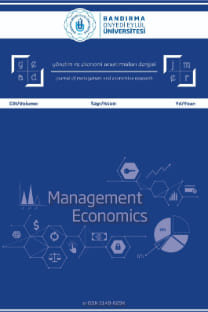Re-Analysis of the EU Public Debt Crises with NARX
EU Public Debt Crises, Southern EU Countries, NARX, Competitiveness Problems
Re-Analysis of the EU Public Debt Crises with NARX
___
- Afonso, A. and Alves, J. (2014) “The Role of Government Debt in Economic Growth”, LISBOA Working Paper, No.16.
- Aghion, P. and Kharroubi, E. (2007) “Cyclical Macro Policy and Industry Growth: The Effect of Countercyclical Fiscal Policy”, IMF Seminars 2008.
- Baldacci, E. and Kumar, M.S. (2010) “Fiscal Deficits, Public Debt and Sovereign Bond Yields”, IMF Working Paper, No.WP/10/184.
- Belguith, S.O. and Omrane, H. (2017) “Macroeconomic Determinants of Public Debt Growth: A Case Study for Tunisia”, Theoretical and Applied Economics, 24(4): 161-168.
- Blyth, M. (2013) “Austerity: The History of A Dangerous Idea”, Oxford University Press, New York.
- Boltho, A. and Carlin, W. (2013) “EMU’s Problems: Asymmetric Shocks or Asymmetric Behavior?”, Comparative Economic Studies, 55(3): 378-403.
- Burriel, P. Westphal, C.C. Pascal, J. Matthias, and S. Nikolai, S. (2020) “Economic Consequences of High Public Debt: Evidence From Three Large Scale DSGE Models”, European Central Bank Working Paper Series, No.2450.
- Burnside, C. Eichenbaum, Martin S. and Rebelo, S. (2001) “Prospective Deficits and the Asian Currency Crisis”, Journal of Political Economy, 10(6): 1155-1197.
- Bosworth, B.P. and Collins, S.M. (2003) “The Empirics of Growth: An Update”, Brookings Papers on Economic Activity, 2: 113-206.
- Calderon, C. and Fuentes, R.J. (2013) “Government Debt and Economic Growth”, IDB Working Paper Series, No.IDB-WP-424.
- Caminal, O.R. (2011) “The EU Architecture to Avert A Sovereign Debt Crisis”, OECD Journal: Financial Market Trends, Volume 2011, No.2.
- Chaudhuri, T.D. and Ghosh, I. (2016) “Artificial Neural Network and Time Series Modeling Based Approach to Forecasting the Exchange Rate in A Multivariate Framework”, Journal of Insurance and Financial Management, 1(5): 92-123.
- Chinn, M.D. and Frieden, J.A. (2012) “The Eurozone in Crisis: Origins and Prospects”, La Follette Policy Report, 21(2): 1-5.
- Chirwa, T.G. and Odhiambo, N.M. (2016) “What Drives Long-Run Economic Growth? Empirical Evidence from South Africa”, Economia Internazionale/International Economics, 69(4): 425-452.
- Chirwa, T.G. and Odhiambo, N.M. (2017) “Sources of Economic Growth in Zambia: An Empirical Investigation”, Global Business Review, 18(2): 275-290.
- ISSN: 2148-029X
- Yayın Aralığı: 4
- Başlangıç: 2013
- Yayıncı: Bandırma Onyedi Eylül Üniversitesi İ.İ.B.F.
INVESTIGATION ON THE EFFECT OF VOLUNTARY SIMPLE LIFESTYLE ON MENTAL WELL-BEING
AMAÇ AZALMASI VE MOTİVASYON KAYBI İLİŞKİSİNDE ÖRGÜTSEL DUYARSIZLAŞMANIN ARACI VE DÜZENLEYİCİ ROLÜ
Hasan TUTAR, Hakan Tahiri MUTLU
Declining Labor Market Informality in Turkey: Unregistered Employment and Wage Underreporting
Yusuf Kenan BAĞIR, Müşerref KÜÇÜKBAYRAK, Huzeyfe TORUN
Re-Analysis of the EU Public Debt Crises with NARX
HOW TO MAINTAIN RELIGIO-INSTITUTIONS: THE CASE OF ALMS-TAX IN THE EARLY ISLAMIC STATE
THE INFLUENCE OF FISCAL POLICY ON UNEMPLOYMENT RATE IN TÜRKİYE
EUROPEAN UNION CARBON BORDER ADJUSTMENT MECHANISM: A SWOT ANALYSIS FOR TÜRKİYE
TÜRKİYE ve AVRUPA BİRLİĞİ ÜLKELERİNDE KAMU EĞİTİM ve SOSYAL KORUMA HARCAMALARI
IMPROVING TURKEY'S NATURAL GAS DEMAND FORECASTS: A DATA ANALYTICS APPROACH
